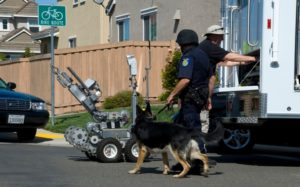SHOULD WE EMBRACE OR IGNORE PREDICTIVE POLICING?

Back in 2002, when I along with a batchmate of mine watched the flick “Minority Report” little did we envisage the possibility of the Orwellian 2054 setting, dawning on us, so fast so soon. It’s been only 16 years since Steven Spielberg’s movie was released, but anyone revisiting the film would realise that some of the futuristic predictions made in the movie like driverless autonomous cars, voice-controlled homes, facial recognition systems, gesture-based computing and most importantly predictive policing have become our reality today. Predictive policing is revolutionising law enforcement. Just like in the movie “Minority Report” it is being used to predict where the next crime would take place.
In India, for several years we have been deploying a rudimentary offline system of predictive policing using Police station records. In Tamilnadu, Part 2 Crime Charts, Part 4 Village History sheets, Ex-convict register, Jail Release Memos etc had the potential to predict the likelihood of a crime taking place within the jurisdiction of the Police station but was seldom used for the purpose. Commissioner of the NYPD (New York Police Department) the ever flamboyant, Bill Bratton in his first tenure in 1994 introduced a Crime management tool called ”CompStat”. This wasn’t a computer system but a statistical tool that processed crime events and arrest reports to arrive at the hotspots of crime in the city. To better describe it, it was simply an improved version of crime charts maintained since last century in the police stations of Tamilnadu, where the crimes and accidents would get reflected in a map. A cluster of crimes or accidents in a close vicinity predictively meant that the particular area deserved frequent beats. This in many ways, amounted to the predictive policing.
In November 2011, TIME Magazine named predictive policing as one of the 50 best inventions of 2011. Collecting storing and analysing data is becoming cheap and easy hence police forces in the world are harnessing the potential of this technology to predict and control crimes. In a 2016 study, an organisation called UpTurn found 20 of the 50 largest police forces in the USA to be using predictive policing. Los Angeles Police Department (LAPD) under the stewardship of Bill Bratten in partnership with a private technology company called Palantir became the pioneer police agency to take a plunge into data-driven policing. It has developed a system called the Real-Time Analysis Response (RTAR) division which integrates, analyses and shares data from a number of law enforcement database sources.
Here’s a glimpse of how predictive policing is being carried at the RTAR Division. Let’s say, a detective investigating a robbery has only two bits of information about an accused ie his name and a rough description. When these two piecemeal clues are fed into the software, the system in a jiffy display, the age, description, address, gang affiliations, vehicle ownership details, address etc of possible suspects. By matching known attributes, the search is further narrowed down to a few choices. Meanwhile, an automated license plate reader installed in the city identifies the possible suspect’s car. Detectives chase down the car and arrest the accused. Game over.
Similarly, when a gang fight erupts between two gangs in the city neighbourhood, the control room directs the patrol car to the scene. Data about the fight, past shootings, gang tensions, geographical street maps etc are pushed to the screens fixed on the patrol vehicles. By the time patrol cars arrive on the scene, the officers are aware of most information about the gangs as well as the terrain and have devised a well-planned strategy to tackle the gangs.
Here’s another scenario. In the roll call, the SHO receives digital maps of the day’s crime forecast which has small red boxes connoting areas of predicted crime. The red boxes have been arrived at by crunching data collected over the years using powerful computers. The red boxes are basically the hot spots on the map, where the patrol vehicles position themselves and deter the criminal actors from victimising that location.
 In 2012, six months after implementing predictive policing in the Foothills area of Los Angeles, property crimes went down by 24 % compared to the previous year. In the neighbouring districts where there was no predictive policing strangely crime rates went up. Hotspot identification led to a drop in burglaries by 26.6 % in Trafford, UK. Scanning crowds to detect nervous behaviour such as fast heartbeats, shifting eyes is being massively carried out by the US Department of Homeland Security. Police in California is using robots to crack down on drugs by crawling through social media posts.
In 2012, six months after implementing predictive policing in the Foothills area of Los Angeles, property crimes went down by 24 % compared to the previous year. In the neighbouring districts where there was no predictive policing strangely crime rates went up. Hotspot identification led to a drop in burglaries by 26.6 % in Trafford, UK. Scanning crowds to detect nervous behaviour such as fast heartbeats, shifting eyes is being massively carried out by the US Department of Homeland Security. Police in California is using robots to crack down on drugs by crawling through social media posts.
Chicago police are using sensors, big data, machine learning and predictive analytics to help combat the gun crime plaguing the city by trying to predict it before it happens.49% and a 66% reduction respectively, in shootings in February and March 2017 was noticed in two places where the technology was deployed. China is developing an advanced Crime Detection System out of its extensive surveillance network. Kanagawa police in Japan has tested a revolutionary method of anticipating crimes and accidents using AI and is intending to use it during the 2020 Olympic Games in Tokyo.
India too has also resolved to jump into the predictive policing bandwagon. Advanced Data Research Institute (ADRIN) is reportedly developing software which will help law enforcement agencies map crime patterns and fix hot spots. National Crime Records Bureau, (NCRB) is reported to have signed a memorandum of understanding with ADRIN.NCRB initially aims to facilitate predictive policing systems in five states – ie Kerala, Odisha, Maharashtra, Haryana and Tripura. In 2016, Delhi police joined up with Indian Space Research Organisation (ISRO) and developed a predictive policing tool called Crime Mapping Analytics and Predictive System (CMAPS). Maharashtra government intends to come out with a predictive policing policy. The Jharkhand police force similarly has ventured to implement an analytical system with the help of IIM Ranchi, which would evaluate criminal data to predict crime-prone zones and Naxal prone areas.
In 2016 researchers reverse engineered the algorithms of predictive policing software of California called Predpol and discovered that it discriminated against communities of colour. Charges of racial and other socio-economic bias can arise out of predictive policing as police resources get concentrated in areas which have disadvantaged and beleaguered populations. That’s the reason why some cities have turned away from implementing predictive policing. In places where a lot of crime occurs but few reports are made, Data-driven policing can lead to underenforcement and in places where people are likely to call the police at a drop of hat, excessive enforcement may result which is a wastage of resources. Besides, algorithms that have been developed have never been made available for scrutiny, as originators of algorithms argue that their technology is a trade secret and disclosing it would damage the business.
Police records all over India are being digitised under the Crime and Criminal Tracking Network and Systems (CCTNS). Tamilnadu enjoys the distinction of being the first state to digitise police records such as the inquest report, arrest card, seizure manager, arrest card etc. The ultimate aim of the entire exercise points at the integration of police, judicial and jail records. To introduce Predictive policing in the entire country we need the exchange of information between neighbouring police stations, districts and states. This seems a little elusive at the moment as some of the segregated law enforcement arms of the state in our country are yet to be connected. At this juncture, State Crime Records Bureau (SCRB) of Tamilnadu has available with it digitised data for the last 5 years. If Tamilnadu wishes to opt for Predictive policing, it can very well do, like the Jharkhand Police and Delhi Police did without depending on the NCRB. Under the circumstances- Should, we embrace or ignore Predictive policing? Is the big question. Big data can revolutionise policing, solve police crime and enhance police accountability and oversight but simultaneously it can mask, reify, and reinforce discriminatory bias and be a threat to privacy and constitutional rights of the citizens. This downside wouldn’t, however, apply to road safety data, where predictive policing could be a game changer in drastically reducing road accidents thereby saving thousands of lives every year.
In the sci-fi film “Minority Report“ the mutant cyborgs come to a conclusion that the film’s protagonist played by Tom Cruise will commit a murder. While trying to prove his innocence, Cruise realises that the PreCrime unit is corrupted from the inside to serve the interests of certain individuals. Hence algorithms in precrime units cannot be treated as infallible. If machines are trained on biased data they too will become biased. In which case it can easily lead to discriminatory policing patterns. The predictive policing methods used today are in adolescence rather than infancy, so in my opinion, the implementation of big data policing begs for thoughtful reflection and public discussion before the actual leap.
Source from: epaper/deccanchronicle/chennai/dt:06.08.2018 & 10.08.2018
 Dr.K. Jayanth Murali is an IPS Officer belonging to 1991 batch. He is borne on Tamil Nadu cadre. He lives with his family in Chennai, India. He is currently serving the Government of Tamil Nadu as Additional Director General of Police, DVAC.
Dr.K. Jayanth Murali is an IPS Officer belonging to 1991 batch. He is borne on Tamil Nadu cadre. He lives with his family in Chennai, India. He is currently serving the Government of Tamil Nadu as Additional Director General of Police, DVAC.


